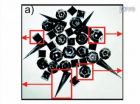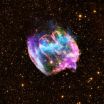(Press-News.org) Electric rocket engines known as Hall thrusters, which use a super high-velocity stream of ions to propel a spacecraft in space, have been used successfully onboard many missions for half a century. Erosion of the discharge channels walls, however, has limited their application to the inner solar system. A research team at Caltech's Jet Propulsion Laboratory, in Pasadena, Calif., has found a way to effectively control this erosion by shaping the engine's magnetic field in a way that shields the walls from ion bombardment.
Ions are produced in Hall thrusters when electrons from an electric current collide with the propellant atoms to form a plasma in the discharge chamber. Thrust is then generated by the interaction of this current with an applied magnetic field that creates a strong electric field. The magnetic field is mostly perpendicular to the channel walls whereas the electric field is mostly parallel to the walls. This electric field then acts as the driving force on the ions, accelerating them to very high speeds (>45,000 mph) toward the exhaust opening. However, the presence of a plasma in the thruster's discharge chamber leads also to a small component of the electric field parallel to the magnetic field lines. This component then accelerates some ions toward the discharge chamber (rather than the exhaust opening) causing erosion by sputtering material from the walls.
Guided by theory and numerical simulations, the research team designed a thruster configuration in which the effect of the plasma on the magnetic field lines along the walls is minimized, forcing the electric field to be perpendicular to the lines. Based on the numerical predictions, the effect of this magnetic field topology would be to accelerate ions away from walls while also significantly reducing their energy adjacent to the walls. Erosion then would be reduced without degrading propulsive performance. The method now known as magnetic shielding was verified by experiments in a vacuum facility using a modified thruster. The combined results of the simulations and experiments demonstrated that there was 100 to 1,000 times less wall erosion when using magnetic shielding. The results were published in the American Institute of Physics (AIP) journal Applied Physics Letters.
###
Article: "Magnetic shielding of walls from the unmagnetized ion beam in a Hall thruster" is published in the journal Applied Physics Letters.
Link: http://apl.aip.org/resource/1/applab/v102/i2/p023509_s1
Authors: Ioannis G. Mikellides (1), Ira Katz (1), Richard R. Hofer (1), and Dan M. Goebel (1).
(1) Jet Propulsion Laboratory, California Institute of Technology, Pasadena, California END
Magnetic shielding of ion beam thruster walls
2013-02-13
ELSE PRESS RELEASES FROM THIS DATE:
Long noncoding RNAs control development of fat cells
2013-02-13
CAMBRIDGE, Mass. (February 13, 2013) – Whitehead Institute researchers have identified a previously unrecognized layer of genetic regulation that is necessary for the generation of undesirable white fat cells. When this regulation is disrupted, white fat cells are unable to accumulate lipid droplets or mature from their precursors.
"We're trying to figure out what the mechanism is—what it takes to make fat cells," says Whitehead Founding Member Harvey Lodish, who is also a professor of biology and a professor of bioengineering at MIT. "The obvious reason we're interested ...
For some, deep brain stimulation brings lasting improvement in neuropathic pain
2013-02-13
Philadelphia, Pa. (February 13, 2013) – For many patients with difficult-to-treat neuropathic pain, deep brain stimulation (DBS) can lead to long-term improvement in pain scores and other outcomes, according to a study in the February issue of Neurosurgery, official journal of the Congress of Neurological Surgeons. The journal is published by Lippincott Williams & Wilkins, a part of Wolters Kluwer Health.
About two-thirds of eligible patients who undergo DBS achieve significant and lasting benefits in terms of pain, quality of life, and overall health, according to the ...
Busy beavers give Canada geese a lift, study shows
2013-02-13
A new University of Alberta study shows that busy beavers are helping Canada geese get an earlier start when the birds fly home and begin spring nesting.
Ponds in Alberta where beavers were active tended to result in earlier thaw of winter snowpack, giving the geese a better chance at reproductive success, according to the study, published recently in Mammalian Biology.
The study is the first to link beavers to early season nesting habits of Canada geese in a Northern climate.
A team led by Glynnis Hood, an associate professor in the Department of Science at the ...
'Masked' mold toxins in food should be included in safety regulations
2013-02-13
Government limits on mold toxins present naturally in grain crops should be expanded to include so-called "masked mycotoxins" that change from harmless to potentially harmful forms in the body, a new study concludes. It appears in ACS' journal Chemical Research in Toxicology.
Chiara Dall'Asta and colleagues explain that molds growing naturally on wheat, corn and other plants produce toxic substances termed mycotoxins. Some health experts regard mycotoxins as the most serious chronic dietary risk factor, greater than the potential health threats from pesticides and insecticides. ...
Origami meets chemistry in scholarly video-article
2013-02-13
February 13, 2013
Cambridge, MA: The nanotechnology research space is rapidly growing, with vast implications for the healthcare, consumer electronics, surveillance, and defense industries. However, a major limitation to this research is the ability to create particles that vary in shape and function on a micrometer or nanometer scale.
To overcome these limitations, chemical engineers at Johns Hopkins University have developed self-assembling particles that are inspired by origami, the traditional Japanese art of folding paper into complex three-dimensional shapes. ...
A cooler way to protect silicon surfaces
2013-02-13
CAMBRIDGE, MA -- Silicon, the material of high-tech devices from computer chips to solar cells, requires a surface coating before use in these applications. The coating "passivates" the material, tying up loose atomic bonds to prevent oxidation that would ruin its electrical properties. But this passivation process consumes a lot of heat and energy, making it costly and limiting the kinds of materials that can be added to the devices.
Now a team of MIT researchers has found a way to passivate silicon at room temperature, which could be a significant boon to solar-cell ...
Protein central to cancer stem cell formation provides new potential target
2013-02-13
HOUSTON - Researchers have identified a pivotal protein in a cellular transformation that makes a cancer cell more resistant to treatment and more capable of growing and spreading, making it an inviting new target for drug development.
Additionally, the international team led by scientists at The University of Texas MD Anderson Cancer Center found the cancer drug sunitinib potentially has a new role in treating triple-negative, claudin-low breast cancer, a particularly resistant version of a type of cancer that is already difficult to treat.
"We found that FOXC2 lies ...
NASA's Chandra suggests rare explosion created our galaxy's youngest black hole
2013-02-13
New data from NASA's Chandra X-ray Observatory suggest a highly distorted supernova remnant may contain the most recent black hole formed in the Milky Way galaxy. The remnant appears to be the product of a rare explosion in which matter is ejected at high speeds along the poles of a rotating star.
The remnant, called W49B, is about a thousand years old as seen from Earth and located about 26,000 light-years away.
"W49B is the first of its kind to be discovered in the galaxy," said Laura Lopez, who led the study at the Massachusetts Institute of Technology. "It appears ...
By guessing, clinicians may miss 3/4 of alcohol problems
2013-02-13
SAN ANTONIO, Texas (Feb. 13, 2013) — By relying on hunches rather than posing a few screening questions, primary care clinicians may be missing three-fourths of the alcohol problems in their patients, a newly released analysis shows.
"It's often off the radar — people come in for hypertension and are not asked how much they drink," said study co-author Barbara J. Turner, M.D., M.S.Ed., M.A., M.A.C.P., of UT Medicine San Antonio. Primary care offices typically don't have good systems to administer questionnaires to screen for certain problems, including alcohol consumption, ...
Tube versus IV feeding in malnourished pediatric cancer patients
2013-02-13
About 60 percent of pediatric cancer patients experience malnourishment during treatment. At that point, patients and families have a choice: tube feeding or IV nutrition supplement. Which would you choose? A study published this week in the Journal of Pediatric Oncology Nursing shows that families' perceptions, especially of the discomfort of tube feeding, leads to choosing IV over tube – despite the fact that tube feeding is usually the better choice, associated with better gut function and lower rates of infection.
"Despite the benefits of tube feeding, we found a ...


